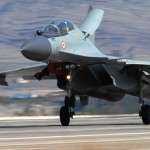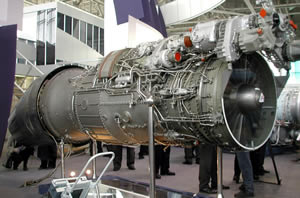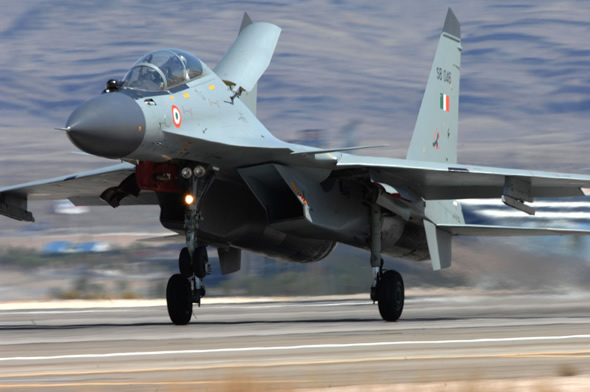
Despite recent the recent crash of a Su-30MKI, Indian Air Force stands behind its first line strike fighter, increasing the planned fleet to 272 aircraft. An order for 42 additional planes was signed yesterday (December 16, 2011) in Moscow, by Defence Secretary Shashi Kant Sharma and Russian Federal Service for Military-technical Cooperation Director MA Dmitriev. India received the first of 120 Su-30MKI fighters in 1997. Follow-on orders have increased the number to 230. The new fighters will be the first newly upgraded models of the Su-30 MKI, provided with upgraded radar, enhanced cockpit displays and avionics, and designed to carry heavier loads, including the air-launched version of the Brahmos supersonic air-to-surface missile.

These 42 new Su-30 MKI will be delivered over four years, beginning 2014. After ramping up local production in India for several years, the Su-30 MKIs are built entirely in India by the Hindustan Aeronautics Ltd (HAL), under license from the original Russian manufacturer Sukhoi.
Until December 2011 the Su-30 MKI fleet demonstrated high reliability and safety record despite two crashes – both in 2009, that were attributed to pilot error (the pilot inadvertently switched-off the fly-by-wire aircraft, the switch was placed behind the seat, clearly a design error that claimed the lives of the two men crew). The second crash was attributed to a foreign object ingestion.
The third crash that occurred December 13, 2011 raised for the first time a concern about the safety of the flight control system. Although there were minor incidents with the Su-30 MKI ‘fly by wire‘ system in the past, none was ended in a crash. The recent crash was different. The aircraft was relatively new, among those built by HAL India in 2009. It was on the first flight following mandatory periodical check (400 flight hours). The system gave no indication about the fault, but controls deteriorated as the plane entered oscillation that evolved and worsened over almost 20 minutes, as the pilot, Wing Commander GS Sohal fought to keep the aircraft flying. Realizing the plane was losing control, WC Sohal and his weapon system operator, Flight Lieutenant U Nautiyal ejected, sending the plane to crash near a village of Wade Bolhai. Russian manufacturer is sending an expert team to investigate the accident and come up with the necessary fixes. The cause of the first accident in 2009 was attributed to a misplacement of a critical switch.
According to sources, in October 2009, one such fighter, participating in Air Force Day fly past over Hindon, UP, got a warning of ‘fly-by-wire’ after takeoff. Immediately, the controls became “sluggish” and it started “pitching up”.
A similar incident that luckily ended safely was reported in October 2009, a month after the first crash. “During recovery and the most critical part of a flight – approach and landing – it experienced continuous oscillations, and was pitching up viciously, nearly uncontrollable,” the Sunday Standard reported, “Post-flight inspection revealed multiple failures of the ‘fly-by-wire’ system, whose quadruple redundancy backs up all parts four times, making it difficult for all to fail at once. With avionics of non-Russian origin, the Su-30MKI has been facing integration problems from the beginning.”

Following the mishape all 120 Su-30 MKI in five bases (Pune, Bareilly, Tezpur, Chabua and Jodhpur) were grounded, limited operations are to resume by Monday December 19, following performing the necessary safety checks. Another concern surfaced recently is the reliability and serviceability of the fighters’ AL-31FP thrust-vectored turbofan engines. The engine powering the Indian fighter is based on the AL-31F turbofan engine developed by Lyulka (renamed NPO Saturn) in 1981 for the Sukhoi Su-27 (Fencer) fighter. The AL-31FP is a thrust-vectoring variant of that engine, developed specifically for export Su-30 versions delivered to India (MKI) and Malaysia (MKM).
The Indian Air Force has elevated the concern of these problems, demanding quick resolution of the issues before the new contract is underway.
Oscillations experienced by a Russian Tu-154 returned to ‘flying condition’ after 10 years in storage.

















